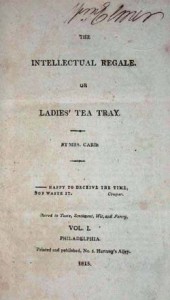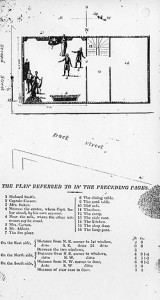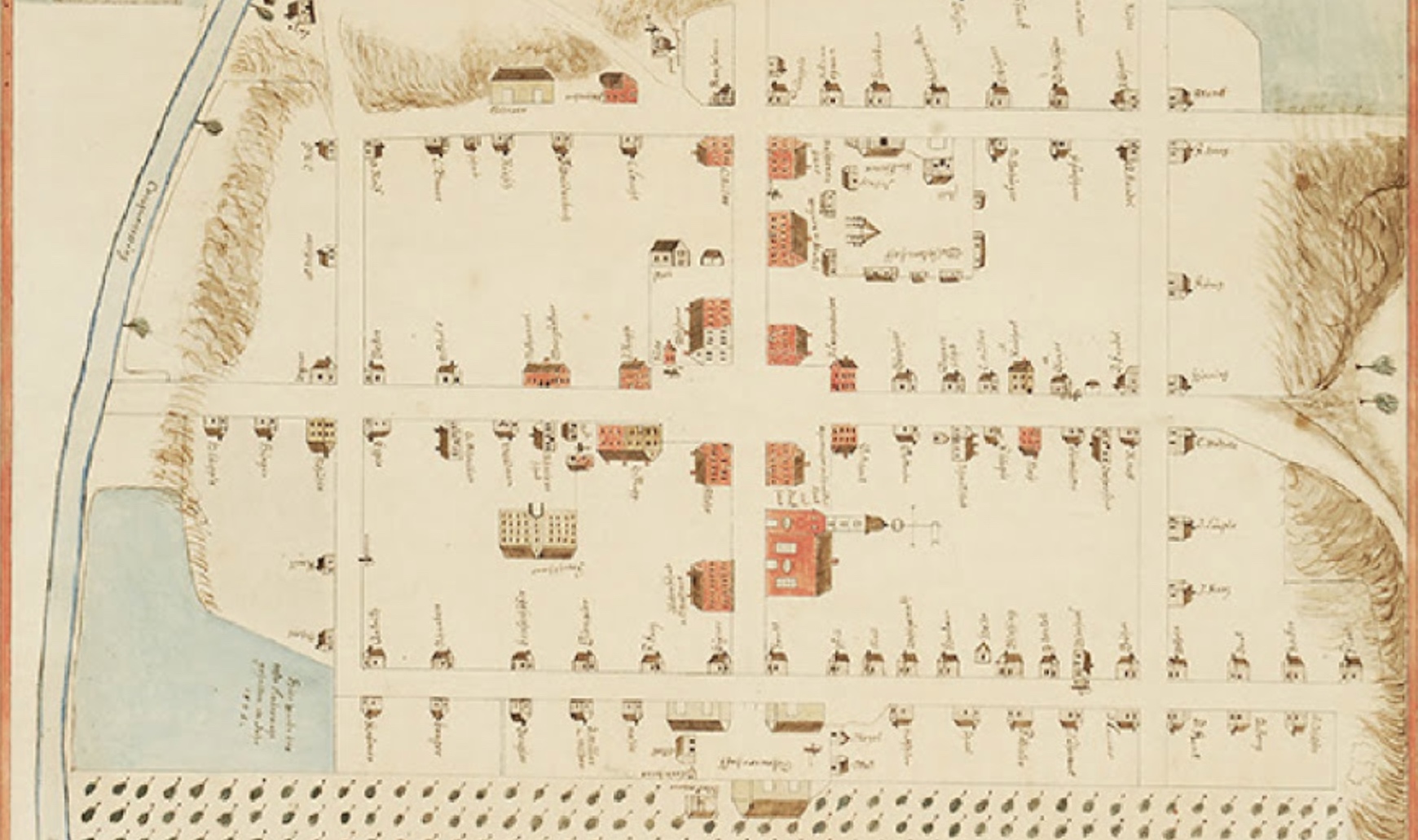Historians are often lucky in their sources. My dissertation, for example, focused on the lives of four women, all of whom had extensive letter collections or diaries, or both. Whatever difficulties I may have had with my dissertation’s argument, or structure, I was not at a loss for primary material. I knew the reading habits, political interests, and social engagements of my subjects. I even knew what they ate and how well they slept at night. I have subsequently discovered, however, that other historical characters left no paper trail to follow, or worse, one that is elusive, uninformative, or downright misleading. Yet these can be the most interesting people of all, and the lack of sources is tantalizing and frustrating. I am now in just such a predicament.
A few years ago I was seduced by the story of a woman who tried to kidnap the governor of Pennsylvania in 1816. The reason you probably have not heard of Ann Carson is because she did not succeed in her attempt. But she did leave a memoir in which she explained the circumstances of her plan and her subsequent criminal activities. Foolishly, I was overjoyed at the prospect of such an abundance of riches. The History of the Celebrated Mrs. Ann Carson (1822) is a two-hundred-page tell-all tale of love, lust, murder, and criminal daring. Yet this seemingly transparent memoir is about as clear as mud when it comes to inconsequential details like names, dates, and actual events. So the real work then began. Each of Carson’s crimes needed substantiation in legal records, newspapers, census records, and city directories. With a great deal of help from my then co-author Susan Klepp, who introduced me to the memoir, we corroborated almost all of Carson’s activities. We also discovered that trial transcripts existed for three of Carson’s four trials. We found evidence of what she did, and, because of the memoir, we had Carson’s interpretation of events. And such a nice juicy story!
I thought I had been lucky in my sources once again, until Susan and I learned that Carson did not write her memoir. She had a ghost writer named Mary Clark Carr. Nine years after Carson’s death, this Mary Carr published a much expanded second edition of Carson’s biography, with a new title, The Memoirs of the Celebrated and Beautiful Mrs. Ann Carson (1838). Only this time, she revealed herself to be the true author of the History, and she told her side of the story for the first time. Here Carr, not Carson, is the heroine of the piece. Mary Carr explains to her readers the true nature of her relationship with the self-styled “beautiful and celebrated” Ann Carson, including the fact that Carson continued to associate with “gentlemen of the black cloth” while living with Carr. And after relying on Mary Carr for room, board, and authorship, Carson betrayed Carr’s trust by stealing her furniture and the unsold copies of the History. The Memoirs offers an intriguing glimpse into the life of this literary ambulance chaser–a woman who walked a fine line between respectability and notoriety. Mary Clark Carr, it turns out, is even more interesting than Ann Carson. Anyone with a gun and a few friends can kidnap a governor, but how many women in the early republic had the talent, initiative, and opportunity to earn their living by writing?
But unfortunately Carr has been much harder to track down. If the History revealed every nook and cranny of Carson’s loves, hates, sexual encounters, and criminal exploits (she was a self-promoter extraordinaire), Mary Carr did her best to keep her private life private–except when she had some reason to do otherwise. And even when she did share facts about herself, they are partial, undated, and unsubstantiated.
I have been completely unsuccessful in uncovering any vital statistics for Carr. She claims to have first met Carson when the two attended confirmation classes under Bishop White at Christ Church (Carson was born in 1785 so I assume this would have been sometime in the 1790s). But no records of a Mary Clark (or any other Marys of the right age) exist. Carr also claimed that her husband died about the same time as Carson’s second husband, Richard Smith, in the summer of 1816. There are no death records for any male named Carr at that time. Mary Carr publicly expressed her wish to be buried where Benjamin Franklin was laid to rest in Christ Church burial ground. But again, the burial records list no Mary Carr. I know only what Carr was willing to reveal.
I soon discovered that Carr wrote other books, and they offer further tantalizing hints about her life. To begin with, Carson probably chose Carr to write the History because Carson knew Carr as the editor of the Intellectual Regale, or Ladies Tea-Tray, a short-lived women’s magazine. In December 1814, Carr announced in a Philadelphia newspaper, the United States Gazette, her proposal for “a Weekly Miscellaneous Paper.” Carr made her motives for undertaking such a risky venture clear: “A Mother will brave death for the support of her children, and she has five who look up to her for support and protection; and by patronizing this work each subscriber will contribute their mite towards assisting her with her family.” Her husband, alive at the time, was never mentioned.
The Tea Tray is unremarkable in its content (F. L. Mott did not even list it in his chronology of magazines). But it is noteworthy for what it reveals about Carr’s business and domestic affairs. Carr inserted frequent comments, apologies, and announcements in the magazine. Almost every issue mentions the difficulties she faced. For instance, Carr relocated her home and the Tea-Tray office in 1815 when she could not pay her rent. She then notified contributors that “in the confusion of moving, several communications have been lost.” A notice in a June 1815 issue reads, “We have to beg pardon from Miss E. B. and our friend S. for not presenting theirs earlier: but they unfortunately fell behind a bureau, from whence they were this week rescued.” Two weeks later another note states, “The editress is mortified to be obliged to present Edgar’s answer to William imperfect. But a part of the copy was carried out of the window by the wind, and was not missed till too late to be replaced.” We can imagine Carr’s household, with five small children and a distracted mother, as untidy, noisy, and disorganized. Unfortunately this information, which delights the modern historian with its peek into the quotidian disarray of Carr’s existence, probably drove away subscribers. The Tea-Tray ended in December 1816, after struggling along, without sufficient funding, for two years.
But what happened between the time the Tea-Tray folded in 1816 and Carr agreed to write Carson’s memoir in 1822? The Memoirshints that Carr published poems and songs. But none seem to have survived. More intriguing still, Carr was a hanger-on in the theatrical world. In addition to The Intellectual Regale, or Ladies Tea-Tray, the History, and the Memoirs, Carr authored several plays (one, The Fair Americans, was performed in Philadelphia in 1815) and two theatrical biographies.
In 1837 Carr published The History of Edwin Forrest. A year later A Concise History of the Life and Amours of Thomas S. Hamblin appeared. Carr included autobiographical details in the biographies to lend authenticity to her version of the lives of these famous (and in the case of Hamblin, infamous) men. For instance, Carr claimed a friendship with Forrest’s brother, William, and based most of what she related in the biography on conversations with him “in the green room of the Chatham Street [New York] theater.” Carr admitted that she had only a nodding acquaintance with Edwin Forrest. What is remarkable, frustrating, and tantalizing is that Carr says she gave the youthful Edwin Forrest “free admission to the theatre of which I was then manager.” Furthermore, she claims he partly owed his professional success to the reviews Carr wrote of his performances, “on his first coming into New York.” Carr managed a Philadelphia theater? Carr wrote theatrical reviews in New York? According to secondary sources, no Philadelphia theaters (there were only a handful) were managed by Carr or by any other woman in the second decade of the nineteenth century. Nor have I been able to find any reviews in her name, unsurprising since many reviews were anonymous. Was Carr lying? I can only assume that there were enough people who could have verified or denied her claims to make it unlikely that she would have fabricated this story.
There is further autobiographical material in Carr’s biography of Thomas Hamblin. Carr wrote it, she says, to expose to the world his greed and immorality, and to show how he had wronged his former wife, actress Elizabeth Blanchard. There may also have been an element of spite in its production: Carr says that Hamblin refused to stage her play The Fair Americans after telling her to her face that “he would be glad to see her prosper.” This biography was written, in large part, as a narrative dictated to Carr by Blanchard, with whom Carr became friends sometime after the Hamblins arrived in New York in 1825. The biography is engaging and salacious (among other things, Carr alleges that Hamblin procured many of his actresses from brothels). But it also hints at Carr’s activities after 1824, the last year chronicled in the Memoirs. In Hamblin’s biography, Carr recounts conversations she witnessed firsthand and confidences shared with her by William Forrest. She also claims that she “edited and published a dramatic paper in New York.” Which one? When? Again I have no evidence to confirm this.
Mary Carr seems to have moved back and forth between Philadelphia and New York, attending the theater and writing critical (and anonymous) reviews of many of the performers named in Hamblin’s biography. What happened to her remains a mystery. I do not know where she died. I do not even know when she died. Mary Carr is an intriguing woman: a pioneer for female authors, publishers, theatrical managers, and critics. But of course I only have her word for that.
This article originally appeared in issue 5.3 (April, 2005).
Susan Branson is associate professor of historical studies at the University of Texas at Dallas. Her book, Notorious by Design: Women, Crime, and Class in Nineteenth-Century America, forthcoming from the University of Pennsylvania Press, details the lives and experiences of Ann Carson and Mary Carr.





















